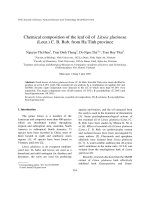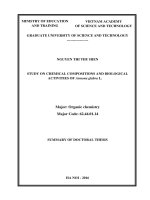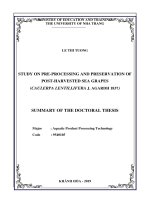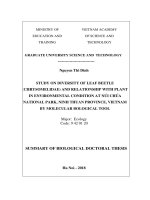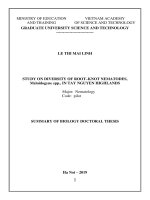Summary of the Doctoral thesis: Study on chemical constituents and biological activities of litsea glutinosa (lour). C. B. Rob. (lauraceae) and lepisanthes rubiginosa (roxb.) Leenh. (sapinda
Bạn đang xem bản rút gọn của tài liệu. Xem và tải ngay bản đầy đủ của tài liệu tại đây (980.58 KB, 26 trang )
MINISTRY OF
VIETNAM ACADEMY OF
EDUCATION AND TRAINING
SCIENCE AND TECHNOLOGY
GRADUATE UNIVERSITY FOR SCIENCE AND
TECHNOLOGY
-----------------------------
PHAM THI NINH
STUDY ON CHEMICAL CONSTITUENTS AND
BIOLOGICAL ACTIVITIES OF LITSEA GLUTINOSA
(LOUR). C. B. ROB. (LAURACEAE) AND LEPISANTHES
RUBIGINOSA (ROXB.) LEENH. (SAPINDACEAE) IN
VIETNAM
Research field : Organic chemistry
Code : 62.44.01.14
SUMMARY OF THE DOCTORAL THESIS
HA NOI - 2018
This thesis is carried out in the Graduate University for
Science and Technology, VAST
Scientific supervisers:
1. Prof. Dr. Sc. TRAN VAN SUNG
2. Dr. TRAN THI PHUONG THAO
Thesis Reviewer 1:
Thesis Reviewer 2:
Thesis Reviewer 3:
The thesis will be defended in the Graduate University for
Science and Technology (GUST) council at Vietnam Academy of
Science and Technology (VAST) at ... on .... 2018
The thesis may be found in the library of the GUST and
National Library of VietNam
2
I. INTRODUCTION
1. Reason of the study
The genus Litsea Lam. (Lauraceae) and Lepisanthes Blume
(Sapindaceae) are wildly distributed in Vietnam, especially in the
mountainous areas. The reports in the literatures indicated that these two
genus contain many constituents with interesting structures and potential
biological activities. In order to find interesting substances for
development of new pharmaceutical ingredients or functional food
products we would like to conduct the resarch thesis ‘‘Study on
Chemical constituents and biological activities of Litsea glutinosa
(Lour.) Rob. (Lauraceae) and Lepisanthes rubiginosa (Roxb.)
(Sapindaceae) in Vienam:
2. Objective of the study in the thesis
The samples of Litsea glutinosa (Lour.) Roxb. [Lauracea] and
Lepisanthes rubiginosa (Roxb.) (Sapindaceae) collected in Vietnam
3. The new contributions of the thesis
- For the first time in Vietnam chemical constituents and
biological activities of two species Litsea glutinosa (Lour.) Roxb.
[Lauracea] and Lepisanthes rubiginosa (Roxb.)Leenh are systematically
investigated. From Litsea glutinosa, 21 compounds were isolated and
structural elucidated, 15 among them are isolated from this species for
the first time. The ethanol-water extract of Litsea glutinosa exhibits
inhibition activity on all 4 cancer cell lines terterd: HepG2, KB, Lu-1 and
MCF-7. Some of the isolated pure compounds from Litsea glutinosa
leaves showed antioxidant activity on DPPH method.
- For the first time in Vietnam, chemical constituents and
biological activities of species Lepisanthes rubiginosa (Roxb.) Leenh are
investigated. From a buthanol extract of this species, 11 compounds have
been isolated and nine ones of them were isolated from L. Rubiginosa
for the first time. The new compounds are glycoside of oleanolic acid
and farnesol.
1
II. The content of the thesis
● Introduction: Interpretation of the reason for the study as well as the
importance in the science and practice of the thesis.
Part 1: Review on the published results of the research objectives
- Review on the reported chemical constituents, biological activities,
distribution in the nature and utilization in the folk medicine related to
two species in the thesis, L. glutinosa and L. rubiginosa
1.1. Botanical characteristics, chemical constituents, and biological
activities of some selected species in the genus Litsea Lam.
1.2. Botanical characteristics, chemical constituents and biological
activities of some selected species in the genus Lepisanthes Blume
Part 2: Experimental
2.1. Chemicals and Equipments for the study
2.2.Plant samples for the study
Twigs and barks of L. glutinosa were collected from Thai Nguyen
province in October 2014 and identified by Ngo Van Hai, Institute of
Ecology and Natural Resources, VAST. An authentic sample is
deposited in Department for Org. Syn., Institute of Chemistry, VAST
(PTN01).
● Leaves and barks of L. glutinosa collected from Thua Thien Hue
province in October 2015 were identified by Ngo Van Hai, Institute of
Ecology and Natural Resources, VAST. An authentic sample is kept in
Department for Org. Syn., Institute of Chemistry, VAST (PTN02).
● Leaves and twigs of L. rubiginosa were collected from the beach of
Phu Loc district, Thua Thien - Hue province in October 2014 and
identified by Do Xuan Cam, university for Agricubture and Forest, Hue
City ( ND01-2014). An authentic sample is deposited in Department for
Org. Syn., Institute of Chemistry, VAST (PTN0).
2.3. Methods in study
2.3.1. Extraction and separation
2.3.2. Determination of the structures
2
2.3.3. Bioassays
Used of: DPPH methol; cytotoxic activity in vitro, diminution of blood
sugar levels in animal test, inhibition of the enzym α –glucosidase,
determination of the acute toxicity in animals.
2.4. Separation, purification of compounds from two studied species
2.4.1. From L. glutinosa (Lour.) Roxb.
2.4.1.1. Compounds from L. glutinosa collected from Thua Thien - Hueprovince.
The dried, powdered leaves were extracted and separated according Fig
2.1.
Fig. 2.1: Extraction and saparation the compounds from L. glutinosa
collected from Thua Thien - Hue province.
3
* Compounds isolated from the water extract
● Compound BL01 ( Nicotiflorin) yellow powder .IR (Kbr): νmax (cm-1):
3339; 2929; 1655; 1554; 1361; 1058; UV (MeOH), λ max (nm): 212,1;
265,8; 349,0 nm; (+) ESI-MS m/z: 617.1 [M+Na]+; (-) ESI-MS m/z:
593,1 [M-H]-; 1H, 13C-NMR, 1D, 2D, spectral data are in agreement with
those in [152].
● Compound BL02 (Rutin) yellow powder; IR (KBr) νmax (cm-1): 3392;
1614; 1518; 1455; 1244; 1007; UV (MeOH) λmax (nm): 206,9; 257,3;
358,0; (+) ESI-MS m/z: 611,0 [M+H]+; (-) ESI-MS m/z: 609,1 [M-H]-;
1
H, 13C-NMR, 1D, 2D spectral data are in agreement with those in [153].
● Compound BL03 (Afzelin) yellow powder; IR (KBr) νmax (cm-1): 3379;
3100; 2920; 1646; 1562; 1459; 1074; UV (MeOH) λ max (nm): 206,9;
265,4; 316,6; (+) ESI-MS m/z: 432,8 [M+H]+; (-) ESI-MS m/z: 431,0
[M-H]-; 1H, 13C-NMR, 1D, 2D spectral data are in agreement with those
in [154].
* Compounds from ethyl acetatee extract
● Compound BL04 (Quercitrin) yellow powder ; IR (KBr) νmax (cm-1):
3415, 3253, 2970, 1655, 1557, 1471, 1052; UV (MeOH), λmax (nm):
206,9 nm); (+) ESI-MS m/z: 471,0 [M+Na]+; (-) ESI-MS m/z: 447,0 [MH]-; 1H, 13C-NMR, 1D, 2D spectral data are in agreement with those in
[155].
The dried, powdered were extracted and separated according to Fig 2.2.
4
Fig. 2.1: Extraction and saparation from compounds the barks and
twigs of L. glutinosa collected from Thua Thien Hue- province.
* Compounds isolated from the water extract
● Compound BL05 (Magnocurarine chloride) yellow powder. HRESIMS m/z: 314,1751 [M-Cl]+ (Molecular formula is C19H24NO3+
314.1756). 1H, 13C-NMR, 1D, 2D spectral data are in agreement with
those in [156].
* Compounds from n-butanol extract
Compound BL06 (Oblongine chloride) yellow powder ; IR (KBr) νmax
(cm-1): 3482, 3239, 2989, 1656, 1556, 1061; UV (MeOH), λmax (nm):
204,8; 245,3; 295,2; Phổ ESI-MS m/z: 314,0 [M-Cl]+; positive HRESIMS m/z: 314,1741 [M-Cl]+; Molecular formula is C19H24NO3+
5
314,1756); 1H, 13C-NMR, 1D, 2D spectral data are in agreement with
those in [157].
● Compound BL07 (Boldine methochloride) yellow powder: ESI-MS
m/z: 342,0 [M-Cl]+; 1H, 13C-NMR, 1D, 2D spectral data are in
agreement with those in [158, 159].
● Compound BL08 (Pallidine) yellow powder: ESI-MS m/z: 328.0
[M+H]+; negative ESI-MS m/z: 326,0 [M-H]-; 1H, 13C-NMR, 1D, 2D
spectral data are in agreement with those in [160].
● Compound BL09 (Predicentrine) yellow powder: ESI-MS m/z: 342,0
[M+H]+. 1H, 13C-NMR, 1D, 2D spectral data are in agreement with those
in [158, 159].
● Compound BL10 (Criptorodine) yellow powder. ESI-MS m/z: 309,9
[M+H]+; 1H, 13C-NMR, 1D, 2D spectral data are in agreement with those
in [161].
Compound BL11 (Reticuline) yellow powder. ESI-MS m/z: 330,0
[M+H]+; 1H, 13C-NMR, 1D, 2D spectral data are in agreement with those
in [162].
● Compound BL12 (Aripuanin) yellow powder; (+)-ESI-MS m/z: 267,0
[M+Na]+; 1H, 13C-NMR, 1D, 2D spectral data are in agreement with
those in [163].
● Compound BL13 (Blumenol A) oil yellow powder ; (+)-ESI-MS m/z:
247 [M+Na]+ data; 1H, 13C-NMR, 1D, 2D spectral data are in agreement
with those in [164].
* Compounds from n-hexane extract
● Compound BL14 (2-phyten-1-ol) white powder: 1H, 13C-NMR, 1D,
2D spectral data are in agreement with those in [165].
2.4.1.2. Extraction and separation the compounds from L. glutinosa
collected in Thai Nguyen
* Compounds from ethyl acetate extract
● Compound BL15 (cis-5,8,11,14,17-eicosapentaenoic acid methyl
erterr) yellow powder. IR (KBr, cm-1): 2923,11 (CH); 1740,14 (COO).
6
ESI-MS m/z: 317,0 (25 %, [M+H]+). 1H, 13C-NMR, 1D, 2D spectral data
are in agreement with those in [166].
● Compound BL16: Spatozoate yellow powder. IR (KBr, cm-1): 2964
(C-H), 1724 (COOR- erter), 1283 (C-O). ESI-MS (m/z, %): 313,0 (98
%) [M+H]+ data: 1H, 13C-NMR, 1D, 2D spectral data are in agreement
with those in [167].
● Compound BL17: β-sitosterol; white powder C 1H, 13C-NMR, 1D, 2D
spectral data are in agreement with those in [168].
● Compound BL18: Daucosterol; white powder 1H, 13C-NMR, 1D, 2D
spectral data are in agreement with those in [169].
* Compounds from n-hexane extract
● Compound BL19 (1-heptadecanol) white powder. ESI-MS m/z: 256,1
(98 %), [M]+, Molecular formula is C17H36O. 1H, 13C-NMR, 1D, 2D
spectral data are in agreement with those in [170, 171].
● Compound BL20 (1-eicosanol) white powder. ESI-MS m/z: 298,2 (15
%) [M]+, 338,2 (80 %) [M+K+H]2+, Molecular formula is C20H42O; 1H,
13
C-NMR, 1D, 2D spectral data are in agreement with those in [170,
171].
● Compound BL21 (Glycerol 1,3-di-(9Z, 12Z-octadecadienoate) 2hexadecanoate) yellow powder. ESI-MS m/z: 875,7 (98 %)
[M+H2O+3H]+; 595,4 (10 %) [M+3H-CO(CH2)14CH3)]+; Molecular
formula is C55H98O6. 1H, 13C-NMR, 1D, 2D spectral data are in
agreement with those in [172].
7
Hình 2.3: Extraction and saparation compounds from
the barks and twigs of L. glutinosa collected in Thai Nguyen
2.4.2. Extraction and separation the compounds from L. rubiginosa
* Compounds from ethyl acetate extract
● Compound ND1 (lupeol) white powder; ESI-MS: m/z 409 (100,
[M+1-H2O]+; M = 426 ; Molecular formula is C30H50O. 1H, 13C-NMR,
1D, 2D spectral data are in agreement with those in [173, 174].
● Compound ND2 (Diosmetin); yellow powder, Molecular formula is
C16H12O6. ESI-MS: m/z 300,9 [M+H]+ và m/z 298,9 [M-H]- data. 1H,
13
C-NMR, 1D, 2D spectral data are in agreement with those in [175].
● Compound ND3: Heptadecanoic acid (Margaric acid, Daturinic acid).
ESI-MS: m/z 271 [M+H]+ data; 1H, 13C-NMR, 1D, 2D spectral data are
in agreement with those in [176].
● Compound ND4: β-sitosterol
● Compound ND5: Daucosterol
8
* Compounds from n-butanol extract
● Compound ND6 white powder . ESI-MS m/z 803,4 [M+Na]+; 815,4
[M+Cl-]- data. 1H, 13C-NMR, 1D, 2D spectral data are in agreement with
those in [178].
● Compound ND7 white powder . ESI-MS data m/z 803,4 [M+Na]+;
815,4 [M+Cl-]-; 1H, 13C-NMR, 1D, 2D spectral data are in agreement
with those in [178].
● Compound ND8 white powder. ESI-MS data tại m/z 977,3 [M+Na]+;
989,4 [M+Cl-]-. HR-ESIMS data m/z 977,5065. 1H và 13C NMR data in
(Fig 3.18).
● Compound ND9 white powder. ESI-MS data, compound of ND9 m/z
935,4 [M+Na]+. HR- ESIMS data pic ion: m/z 935,4929 [M+Na]+. 1HNMR và 13C-NMR spectral data are in agreement with those in (Table
3.19).
● Compound ND10 white powder. ESI-MS data pic tại m/z 963,4
[M+Na]+ và 939,4 [M-H]-; HR- ESI-MS ; m/z 963,4314 [M+Na]+. 1HNMR và 13C-NMR spectral data are in agreement with those in (Table
3.19).
● Compound ND11 white powder. ESI-MS data m/z 979; HR-ESI-MS
m/z 979,41760. 1H-NMR và 13C-NMR spectral data are in agreement
with those in (Table 3.19).
[173, 174].
9
Hình 2.5: Extraction and separation the compounds from L.
rubiginosa
Part 3: Results and discussions
3.1. About L.glutinosa
3.1.1. Biological activity of the extracts of L.glutinosa from Thua
Thien Hue province
3.1.1.1. Inhibition activity of α- glucosidase of the extracts in vitro
The activity in decreasing of the blood sugar levels of the ethanol/ water
extracts of the barks and leaves of L.glutinosa from Thua Thien Hue
province was terterd on the inhibition of α- glucosidase activity. The
result showed that the EtOH/H2O (80:20) extracts possessed the
inhibition of α- glucosidase activity with the IC50 value of 194,9 (barks)
and 197.3 μg/ml (leaves). Acarbose was the reference (IC50 165 μg/ml).
3.1.1.2. The activity in decreasing the blood sugar level on the diabetinduced mice of EtOH/H2O (80:20) extracts.
10
● Influence of the extract on the body weights of the mice: The body
weights of mice before and after use of EtOH/H2O extracts are given in
table 7. The result: In the doses of 250mg extract and 500mg extract/kg
body weight, the weights of mice do not changed.
● The effect of EtOH/H2O extract on the serum glucose concentration of
the diabet- induced mice (Table 3.3): The extract showed significant
activity in the decreasing the serum glucose level of the terterd mice.
3.1.2. Chemical constituents of L. glutinosa
3.1.2.1. Compounds from L. glutinosa collected in Thua Thien Hue
From the leaves, twigs and barks of this sample, 15 compounds have
been isolated and elucidated. They included: 4 flavonol glycosides
(compounds BL01-BL04), 7 aporphin alkaloids (compounds BL 05BL11), 2 megastigmanes (BL12 , BL13) and 1 phytol (BL14).
3.1.2.2. Compounds from L. glutinosa collected in Thai Nguyen
From n-hexane , ethyl acetate of the barks and twigs 10 compounds were
isolated and structural determined. The compounds from two samples
collected in Thai Nguyen and Thua Thien Hue province are presented in
Table 3.20
Table 3.20: Compounds from L. glutinosa
Bảng 3.20: Compounds from L. glutinosa isolated from in Thai nguyên va
Thua Thien Hue
L. glutinosa Thai Nguyen
L. glutinosa Thua Thien Hue
BL15 (Cis-5,8,11,14,17-eicosapentaenoic
acid
methyl erter)
11
BL01 (Nicotiflorin)
BL16 (Spatozoate)
BL02 (Rutin)
BL17 (β-sitosterol)
BL03 (Afzelin)
BL18 (Daucosterol)
BL04 (Quercitrin)
BL19 (1-heptadecanol)
BL05 (Magnocurarine chloride)
BL20 (1-eicosanol)
BL06 (Oblongine chloride)
BL21 (Glycerol 1,3-di(9Z,12Zoctadecadienoat)-2-hexadecanoate)
BL07 (Boldine methochloride)
12
BL08 (Pallidine)
BL09 (Predicentrine)
BL09 (Predicentrine)
BL10 (Criptorodine)
BL10 (Criptorodine)
BL11 (Reticuline)
BL11 (Reticuline)
BL12 (Aripuanin)
BL13 (Blumenol A)
BL14 (2-phyten-1-ol)
* From a literature search, it resulted that: Among 21 isolated
compounds there are 15 compounds, which were first time isolated from
the species L. glutinosa (Lour.) Roxb. (BL01, BL05- BL10, BL12BL16, BL19-BL21)
13
3.1.3. Biological activity of pure isolated compounds
3.1.3.1. Cytotoxic activity
The compounds BL01- BL11 were terterd on four human cancer cell
lines as KB, HepG2, Lu and MCF-7, Ellipticine was used as positive
control. The results are given in Table 3.10
Table 3.10: Cytotoxic activity of the compounds BL01- BL11, isolated
from Thua Thien Hue sample
IC50 (g/ml)
Compound
BL01
BL02
BL03
BL04
BL05
BL06
BL07
>128,0
>128,0
>128,0
>128,0
67,66
68,49
>128,0
Hep
G-2
>128,0
>128,0
>128,0
>128,0
117,08
82,75
>128,0
BL08
BL09
21,29
17,72
13,56
25,6
>128,0
56,32
29,24
54,21
BL10
BL11
68,39
>128,0
>128,0
>128,0
>128,0
>128,0
>128,0
>128,0
Ellipti
0,31
0,38
0,41
0,60
KB
Lu
MCF-7
>128,0
>128,0
>128,0
>128,0
>128,0
>128,0
>128,0
>128,0
>128,0
>128,0
>128,0
>128,0
>128,0
>128,0
cine
As the results: Some aporphin alkaloids (BL05, BL08, BL09) showed
cytotoxic activity on four terterd cell lines. This is the fist report on the
cytotoxic activity of the above alkaloids.
3.1.3.2. The antioxidant of the pure compounds
The flavonoids BL01-BL04 were terterd on the antioxidant activity.
Quercetrin was used as a reference with the IC50 =9.45µg/ml (Table 3.5).
As the result: Compound BL02 (rutin) and BL04 (quercitrin) exhibited a
good antioxidant activity with the IC50=23.73 and 38.20µg/ml,
respectively. This result confirmed that the flavonoid compounds are
responsible for the antioxidant activity of L. glutinosa.
14
3.1.3.3. The inhibition activity of α - glucosidase of the pure isolated
compounds
The compounds BL01-BL11 were evaluated on the inhibition of α glucosidase activity. As the results: From these compounds only
compound BL04 (quercitrin) showed a good inhibition of α –glucosidase
with IC50 149.5µg/ml in comparison to acarbose (IC50 165.7µg/ml) The
remained compounds showed no inhibition of α -glucosidase (Table
3.10). This result is in agreement with the result published before.
According to [142] quercitrin isolated from the ethyl acetate of Amomum
xanthioides, was determined as the inhibitor of α - glucosidase, with
55.7% inhibition in a concentration of 5mg/ml, higher than acarbose
(32.4%) in the same concentration.
3.1.4. The acute toxicity of the EtOH/H2O extract
Based on a bigger number of constituents in Thua Thien Hue sample we
carried out the determination of the acute toxicity of the EtOH/H2O
(80/20) extracts from this sample. This sample also will be the starting
material for the farther research. The obtained result showed: This
extract had a low toxicity. The lethal dose (LD50) of it on the animal is
>20g/kg body weight (LD50 > 20g/kgP) According to the classification of
GHS, this extract is non-toxic.
3.2 The Lepisanthes rubiginosa (Roxb.) Leenh.
3.2.1. Biological activity
3.2.1.1. Cytotoxic activity
The n-BuOH extract of leaves and twigs of Lepisanthes rubiginosa
(NDL- Bu) was evaluated for cytotoxic activity in vitro. The result is
given in Table 3.14
Table 3.14: Cytotoxic activity of the n-BuOH extract of the L.
rubiginosa
STT
1.
extract
NDL-Bu
Ellipticine
IC50 (µg/ml)
HepG2
MCF7
23,42
18,37
0,41
0,48
KB
21,33
0,40
15
Lu
20,01
0,45
The result in Table 3.14 showed that the n-BuOH extract of the leaves
and twigs of L. rubiginosa (NDL- Bu) is active against all four terterd
cancer cell lines (KB, HepG2, Lu, MCF-7). Among them, the activity
against the cell MCF-7 is good. (IC50 =18.37µg/ml), followed by the Lu
(IC50 =20.01µg/ml), KB (IC50 =21.33µg/ml) and HepG2 (IC50
=23.42µg/ml).
3.2.2. Chemical constituents of L. rubiginosa
● Compound ND8 (New compound)
Compound ND8 was isolated as a white amorphous powder.
1
The H and 13C NMR compound ND8 indicated this compound is
a glycoside with oleanolic acid as aglycone, connected to sugar
moiety at C-3 (Matsuda et al. 1998). The ESI-MS spectra of ND8
contained the pseudomolecular ion peaks at m/z 977.3 [M+Na]+,
989.4 [M+Cl]- and 977.5065 [M+Na]+ (calcl. for C49H48O18Na:
977.5086. Its NMR spectra indicated the presence of an acetyl
group (δH 2.08 (3H, s)/ δC 20.63, 172.57). That means, the sugar
moiety should consist of 17 carbon atoms, equal to two hexoses
and one pentose, which are proved by three anomeric atoms [(δH
4.49 (d, J = 8.0 Hz), 4.73 (d, J = 8.0 Hz), 5.24 (d, J = 2.0 Hz)/ δC
103.74, 105.38, 110.93], three oxymethylene groups [δC 65.01, δH
4.35 (dd, J = 11.5, 3.0 Hz); 4.16 (d, J = 11.5); δC 63.67, δH 3.833.87 overlapped, 3.56-3.59 overlapped; δC 62.76, δH 3.88-3.89,
3.72-3.73 overlapped], together with eleven oxymethine groups. In
comparison with the data in (Andesegun et al. 2008; Chaturvedula
et al. 2003) the sugar residue is a trisaccharide consisted of one βD-glucopyranose, one α-D-galactopyranose and one α-Larabinofuranose which is binded to the C-3 of oleanolic acid by βD-glucopyranose. This suggestion was supported by HMBC
correlations between: H-1’ (δH 4.49) and C-3 (δC 92.31) and H-3
16
(δH 3.23, dd, J = 4.0, 10.5 Hz) and C-1’ (δC 103.74). The α-Larabinofuranose is connected to β-D-glucopyranose at C-3’ (δC
78.57), which is evidenced by the HMBC correlations between H1’’ (δH 4.73) and C-3’ (δC 78.57); H-3’ (δH 3.64, t, J = 9.5 Hz) and
C-1’’ (δC 110.93). The α-D-galactopyranose is connected to β-Dglucopyranose at C-4’, indicating by the HMBC correlations from
H-1’’’ (δH 5.24) to C-4’ (δC 82.13) and C-1’’’ (δC 105.38) to H4’(δH 3.75, t, J = 9.5 Hz). Finally, the acetyl group is proved to
bind to C-6’ (δC 65.01, δH 4.35; 4.15) by the correlations between
H-6’a (δH 4.35), H-6’b (δH 4.15) to C-5’ (δC 77.99), C-4’ (δC 82.13)
and COCH3 (δC 172.57) in the HMBC spectrum (Fig. 3.34). From
the above data and by comparison with the similar compounds in
(Andesegun et al. 2008) compound ND8 was determined as 3-O{α-L-arabinofuranosyl-(1→3)-[α-D-galactopyranosyl-(1→4)]-6O-acetyl-β-D-glucopyranosyl}-oleanolic acid. This is a new
compound and is named as Lepisantheside A. The NMR spectral
data of compound ND8 were given in Table 3.18.
● Compound ND9 (New compound)
Compound ND9 was isolated as a white amorphous
powder. It showed the pseudomolecular ion peaks at m/z 935.4
[M+Na] in its ESI-MS and 935.4929. [M+Na] in HR- MS spectra
(Calc. for C17H76O17Na : 935,4980. This data suggest 2 is also a
trisaccharide of a triterpenoid. The H and C NMR spectra in the
aglycon region are quite similar to those of compound 1. So that
the aglycone of ND9 should be also oleanolic ac id, which is
binded to the sugar moiety at C-3 position. (δ : 92.31, δH-3: 3.23
(dd, J = 12.0, 4.5). The trisaccharide residue also composed from
two hexose and one pentose, which were identified as two β-Dglucopyranose and one β-D-xylopyranose by comparison with the
similar sugar moiety in (Nagao T. et.al.1991; Ito A. et.al. 2004).
The β-D-glucopyranose is binded to C-3 of oleanolic acid, which
+
1
13
C-3
17
is evidenced by the HMBC correlations between H-1’ (δ 4.49) and
C-3 (δ 92.31; H-3 (δ 3.23) and C-1’ (δ 105.55); H-1’ (δ 4.49) and
C-2’ (δ 78.54). The second β-D-glucopyranose is connected to C2’ which is evidenced by the HMBC correlation between H-1’’ (δ
4.99) and C-2’ (δ 78.54), while the β-D-xylopyranose was bound
to C-3’ through the cross peak between H-1’’’ (δ 4.61) and C-3’
(δ 87.95). Besides, the following correlations were observed in the
HMBC spectrum of compound ND9: H-5’’’ axial (δ 3.94, dd, J =
5.5, 11.5) to C-4’’’ (δ 69.88) and C-1’’’ (δ 105.03); H-2’ (δ 3.74)
to C-3’ (δ 87.95) and C-1’ (δ 105.55); H-2’’ (δ 3.15, t, J = 9.5 Hz)
to C-5’ (δ 78.32) and C-6’ (δ 63.66 (Fig.1). The H,H-COSY and
ROESY spectra of compound ND9 also supported the results of
the HMBC spectrum. The correlations between H-1’ (δ 4.49) and
H-3 (δ 3.23); H-1’’ (δ 4.99) and H-2’ (δ 3.74); H-1’’’ (δ 4.61)
and H-3’ (δ 3.70, t, J = 9.0 Hz) in the ROESY spectrum as well as
the correlations between the protons in one sugar molecule moiety
to each other in the H,H-COSY spectrum were observed. From the
above data the structure of compound ND9 was elucidated as 3-O{β-D-glucopyranosyl-(1→2)-[β-D-xylopyranosyl-(1→3)]-βDglucopyranosyl}-oleanolic acid. This is a new compound and is
named as Lepisantheside B. The NMR data of ND9 were given in
Table 3.18
H
C
H
C
H
C
H
C
H
C
H
C
C
C
C
C
H
H
C
H
H
H
H
H
H
Table 3.18: NMR spectral data of compound ND8 and ND9
Vị trí
1
δC
39,80
2
27,08
3
4
5
6
92,31
40,58
57,01
19,33
7
34,02
8
40,50
ND8
δH (J = Hz)
1,62-1,59 m; 1,03-1,00
m
1,98-1,97 m; 1,78-1,76
m
3,23 (dd; J = 10,5; 4,0)
0,81-0,79 m
1,62-1,59 m; 1,43-1,42
m
1,56-1,52 m; 1,23-1,20
m
-
18
δC
39,81
27,08
92,31
40,57
57,01
19,32
34,00
40,50
ND9
δH (J = Hz)
1,63-1,61 m; 1,03-1,00
m
1,99-1,97 m; 1,78-1,73
m
3,23 dd (J = 12,0; 4,5)
0,81 -0,79 m
1,53-1,50 m; 1,43-1,41
m
1,53-1,50 m; 1,34-1,31
m
-
9
10
11
12
13
14
15
49,51
37,89
24,54
123,55
145,32
42,91
28,88
16
24,14
17
18
19
48,49
42,75
47,34
20
21
31,62
34,96
22
33,90
23
24
25
26
27
28
29
30
-OCOCH3
-OCOCH3
Đường
Glc-1’
2’
3’
4’
5’
6’
28,32
16,83
15,90
17,78
26,39
181,90
33,59
24,00
172,57
20,63
103,74
75,96
78,57
82,13
77,99
65,01
1,61-1,59 m
1,92-1,91 m
5,26 (brs)
1,78-1,76 (m); 1,17-1,13
(m)
2,00-1,98 m; 1,56-1,52
m
2,87 (d; J = 11,5)
1,71-1,68 m; 1,17-1,13
m
1,43-1,41 m; 1,23-1,20
m
1,52-1,50 m; 1,34-1,32
m
1,09 s
0,88 s
0,97 s
0,84 s
1,17 s
0,92 s
0,96 s
2,08 s
49,51
37,88
24,54
123,55
145,33
42,90
28,87
4,49 (d; J = 8,0)
3,75-3,73 m
3,64 (t, J = 9,5)
3,75 (t, J = 9,5)
4,21 (dt; J = 6,5; 3,0)
4,35 (dd; J = 11,5; 3,0)
4,16 (d, 11,5)
105,55
78,54
87,95
72,55
78,32
63,66
Xyl-1’’’
2’’’
3’’’
4’’’
5’’’
24,21
48,49
42,88
47,34
31,63
34,96
34,01
28,28
16,84
15,91
17,78
26,39
181,90
33,60
24,00
105,03
75,27
78,27
77,65
67,17
19
1,59-1,56 m
1,93-1,91 m
5,26 (brs)
1,78-1,76 m; 1,17-1,13
m
1,98-1,97 m; 1,59-1,56
m
2, 89 (d; J = 12,0)
1,71-1,68 m; 1,17-1,13
m
1,43-1,41 m; 1,23-1,208
m
1,53-1,50 m; 1,34-1,31
m
1,09 s
0,89 s
0,97 s
0,84 s
1,17 s
0,92 s
0,96 s
4,49 (d; J = 8,0)
3,74 (m)
3,70 (t, J = 9,0)
3,09 (t, J = 9,5)
3,31-3,29 m
3,88-3,83 m
3,67 (dd; J = 12,0; 5,0)
4,61 (d; J = 7,5)
3,26-3,28 m
3,29-3,28 m
3,52-3,54 m
3,94 (dd; J = 11,5; 5,5)
3,28-3,31 m
Glu-1’’
2’’
3’’
4’’
5’’
6’’
103,18
76,19
78,43
70,99
78,53
62,74
Gal-1’’’
2’’’
3’’’
4’’’
5’’’
6’’’
105,38
72,46
78,26
70,19
77,58
63,67
Ara-1’’
110,93
5,24 (d; J = 2,0)
3,23-3,18 m
3,41-3,39 m
3,09 (t; J = 9,5)
3,66-3,65 m
3,87-3,83 m; 3,59-3,56
m
4,73 (d; J = 8,0)
2’’
83,32
3,67-3,66 m
3’’
78,31
3,89-3,88 m
4’’
87,86
3,62-3,54 m
5’’
62,76
3,89-3,88 m; 3,73-3,72
m
4,99 (d; J = 7,5)
3,15 (t; J = 9,5)
3,29-3,28 m
3,08 (t; J = 9,5)
3,33-3,31 m
3,84-3,83 m; 3,58-3,55
m
* Eleven compounds have been isolated and identified from L.
rubiginosa , among them 4 compounds were identified as new
compounds. They are glycosides of oleanolic acid (ND8, ND9) and
pentaglycosides of farnesol (ND10, ND11). Seven other compounds
were isolated from this plant for the first time. The isolated compounds
are presented in Table 3.20
Bảng 3.20: compounds isolated from (Lepisanthes rubiginosa (Roxb.)
Leenh.)
ND2 (Diosmetin;
5,7,3'-Tryhydroxy-4'methoxyflavone)
ND1 (Lupeol)
20
ND3 (Heptadecanoic acid;
Magaric acid; Daturinic acid)
ND4 (R=H: β-sitostosterol)
ND5 (R= β-D-glucose; sitosterol3-O-β-D-glucopyranoside)
ND7 (3-O-[β-D-xylopyranosyl
(1→3)β-D-glucopyranosyl-]-oleanoic
acid)
ND6 (3-O-β-sophoroside)
ND8 (Lepisantheside A) mới
ND9 (Lepisantheside B) mới
21
Conclusion and suggestion
Conclusion
● Chemical constituents of L. glutinosa (Lour.) Rob.
- From the Thua Thien Hue sample: 14 compounds were isolated and
identified, among them 7 aporphine alkaloid , 4 flavonoid glycosides,
two megastigmanes and one sterol.
- From the Thai Nguyen sample 10 compounds were isolated and
elucidated including 3 aporphine alkaloid (two of them are also found in
Thua Thien Hue sample) and derivatives of fatty acid and fatty alcohols.
- 15 isolated compounds were found in L. glutinosa for the first time.
● Chemical constituents and Biological activity of L. rubiginosa (Roxb.)
Leeh.
- 11 compounds were isolated and identified from L. rubiginosa,
including 4 new compounds, which are the glycosides of oleanolic acid
(ND8, ND9), and farnesol ND10, ND11. They are named as
Lepisantheside A, B, C, D, respectively). Seven compounds were
isolated from this species for the first time.
● Biological activity
The blood sugar level lowering effect on diabet- induced mice of the
EtOH/H2O (8/2) extract of Thua Thien Hue sample was evaluated . The
result: With the doses 250 and 500mg /kg body weight, the blood sugar
22
level of animal were decreased significantly in comparison to the
control. The 500mg/kg body weight showed an effect which
comparatible with acarbose 5mg/kg body weight.
The LD50 of the EtOH/H2O (8/2 vv) extract of Thua Thien Hue was
determined. The LD50 is > 20g/kg P. So that this extract is considered as
none toxic. The cytotoxic, antioxidant and α-glucosidase inhibition
activity of 11 pure isolated compounds were evaluated. Some of them
showed moderate activity.The n- BuOH extract of L. rubiginosa
exhibited the inhibition on all four terterd cancer cell lines: KB, Hep G2,
MCF-7 Lu-1
Suggestion
- Further studies on the mechanism of the blood sugar lowering effect of
the plant studied
- Further investigation on the cytotoxic acticity of – BuOH extracts of L.
rubiginosa
New contribution of the thesis
- Systematical investigation on the chemical constituents of L.
glutinosa
- Isolation of 21 com compounds from L. glutinosa,among them
15 compounds were isolated for the first time from this species.
- The cytotoxic, antioxidant and α-glucosidase inhibition
,antidiabetic of pure compounds from L. glutinosa were reported
for the first time.
- 4 new compounds (glycosides of oleanolic acid and farnesol)
were isolated from L. rubiginosa together with 7 ones isolated
for the first time from this species.
23
